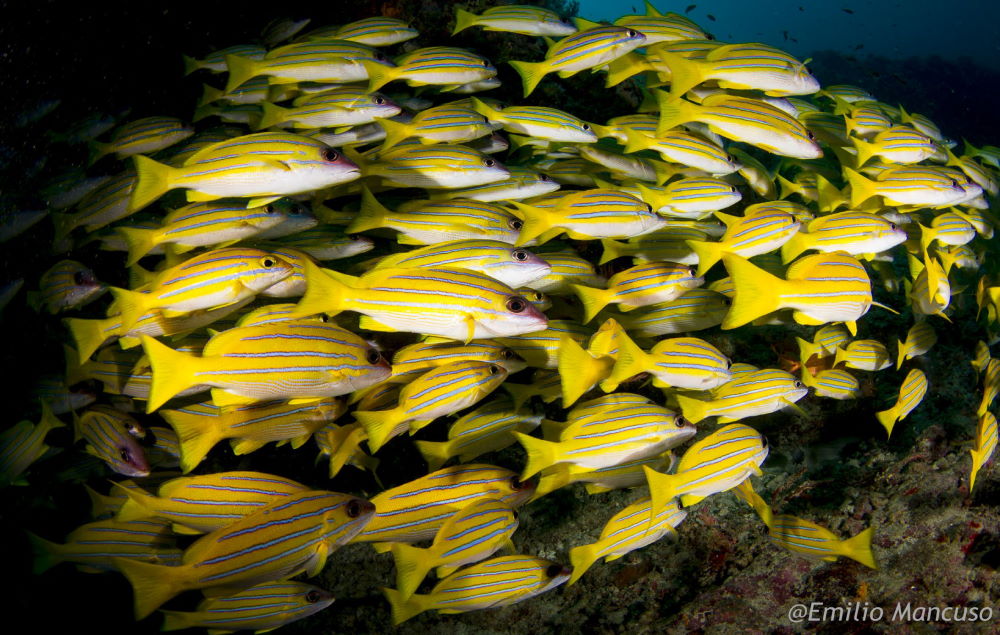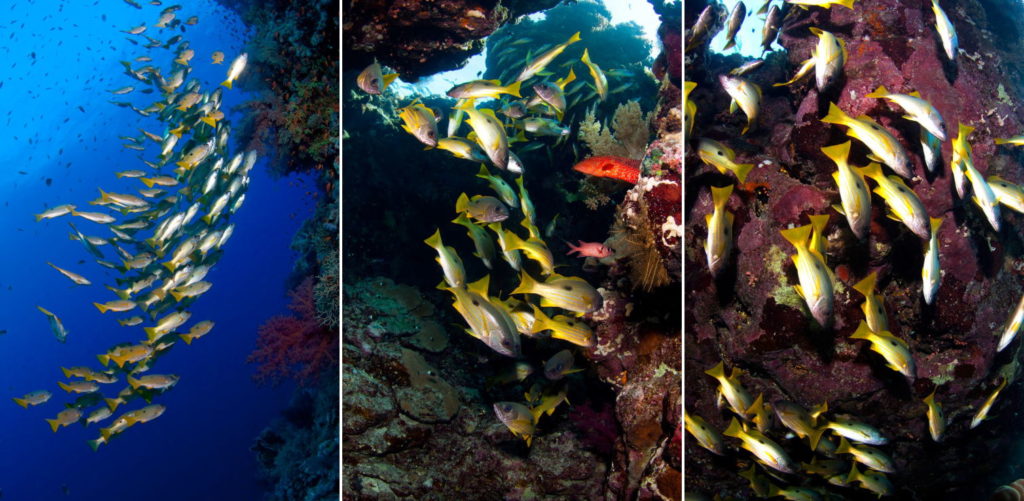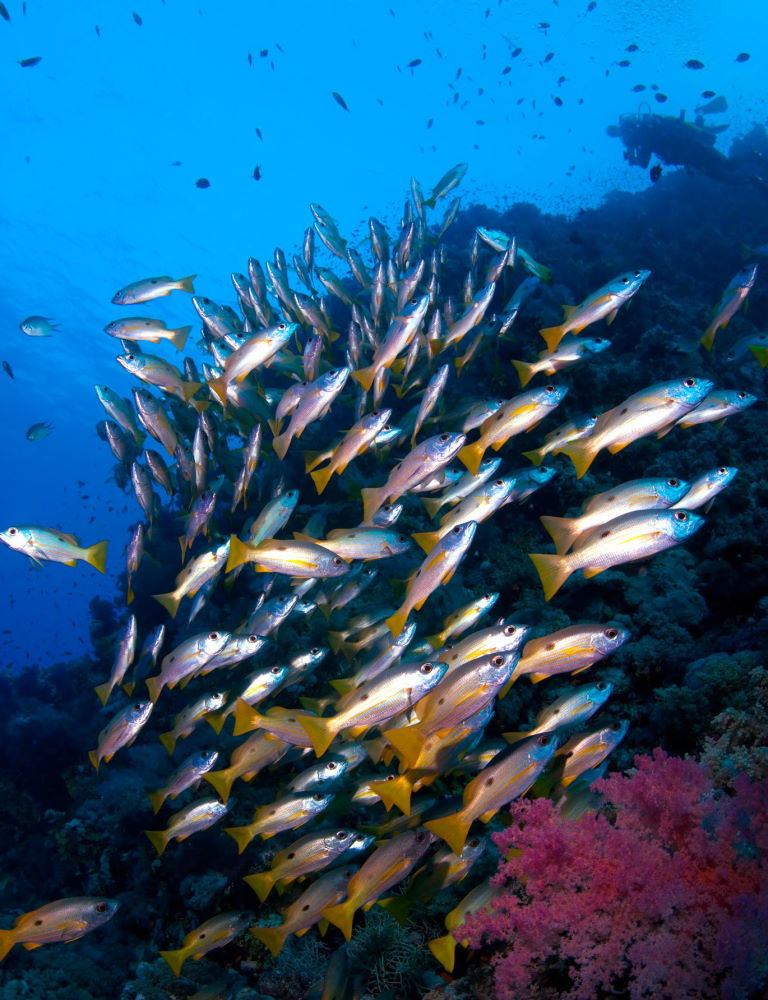
Biological introduction
The Lutjanidae is a family of very recognizable and well represented fish, with about 100 species present throughout the world (many are deep, different inhabit estuaries and some are present even in fresh water).
This family is known to us, in “multilanguage” mode, as that of the Snappers. Because of their quite evident teeth they are often confused for unlikely “tropical dentex”, but for the rest they are quite recognizable for the tapered snout, the only dorsal fin and for the presence, in many species, of a black spot in the second half of their body that often has a livery characterized by longitudinal lines.
DEPTH
Most snappers recognizable during our dives lives within the first 30-40 meters deep, with the juveniles inhabiting the most superficial waters, while adults tend to occupy more the reef slopes. Among those known to divers are the bluestripe snapper and the mangroves snapper that, as per the literature, are distributed up to about 130 meters deep. The most recognizable “Big Jobfish” (Aprion virescens) reaches up to 100 meters, but apparently the record of distribution goes to the fusilier snapper (Japanese Snapper Paracaesio cerulean), which reaches up to 200 meters of bottom, and which by its name reminds us how snappers and fusiliers are closely related families.
CURIOSITY
Undoubtedly the main curiosity is linked to their common name: Snapper. From such a name you might expect aggressive behavior, while the vast majority of snappers we observe, typically those with the gregarious behavior, are gentle carnivorous that feed on crustaceans and small fish, both benthic and planktonic. Although very shy, solitary and difficult to approach, among all the snappers those with the most voracious behavior are the “jobfish” that often attract the divers’ attention for their sudden movements.
APPROACH AND OBSERVATION
Typically, snappers that attract our attention are the gregarious ones that are moving in schools inside lagoon areas or along the reef’s slopes. For a pleasant and proper observation of these individuals we have to concentrate on the school and not on the individual, or rather consider the school as it were a single moving fish. Keeping the right distance, considered by the school as that of security, we will be able to observe them in their moving, noting how often other fish, belonging to completely different families, enter and mix with the school. On the other hand, if the desire to get closer to the individual will lead us to being too impetuous, the school will respond by dispersing and moving away, resulting in seeing only fish tails that quickly will leave us “alone on the reef”.

Sweetlips
BIOLOGY
Undoubtedly the feature that makes them more recognizable, hence their common name, is the fleshiness of their lips. For the rest, the Sweetlips, also known as grunts, belong to the Haemulidae family, expressed by nearly 130 species in the Atlantic Ocean, Red Sea and Indo-Pacific. The body is more massive than the snappers, with a high profile at the end of the head and liveries that tend to play on whites, yellows and blacks. The elegance of the movements and the daytime behavior, typically resting in the shade of acroporas, in caves or wrecks, made the sweetlips associate their decidedly fanciful Italian common name of “ombrine tropicali” (that is “tropical croaker”, but “ombrine” in Italian means literally “little shadows”).
DEPTH
Whether they are solitary or gregarious, the Sweetlips don’t like big depths too much: they normally live on the reef within the first 30 to 40 meters, moving more actively at night, when they scour sandy or detrital seabeds in search of the benthic invertebrates they feed on.
CURIOSITY
Among the curiosities, above all the one linked to the name of Grunts: in fact, as well as sweetlips, in English they are also called “grunt fish”. You will never hear these fish grunting in the Red Sea: in fact, this name derives from some Caribbean species capable of producing a sort of grunt by rubbing the pharyngeal teeth. From a more scientific perspective, on the other hand, is rather curious that their taxonomic classification has
been widely revised, even recently, mostly because of the great diversity of shapes and colors that the species exhibit between the juvenile and adult states, which has very often confused their recognition.

APPROACH AND OBSERVATION
Being nocturnal predators, they move very little during the day and are easily identifiable in the shady areas of the reef: a very slow approach will allow us to observe the elegance of their liveries, and we will easily see their big lips being object of “orthodontic care” by some cleaner wrasse. Very often, watching a fish from the tail side may seem boring, but Sweetlips’ tails deserve an eye of attention, partly due to their very fascinating liveries (the most famous Sweetlips, the one with black spots “Plectorhinchus gaterinus” deserved beautiful “butt” pictures) partly because, especially when we observe the juvenile forms of Haemulidae, it is precisely the disproportionate movement of their caudal fins to give us the clue that we find ourselves in front of a member of this family.
WORDS and PICTURES by Massimo Bicciato and Emilio Mancuso


















